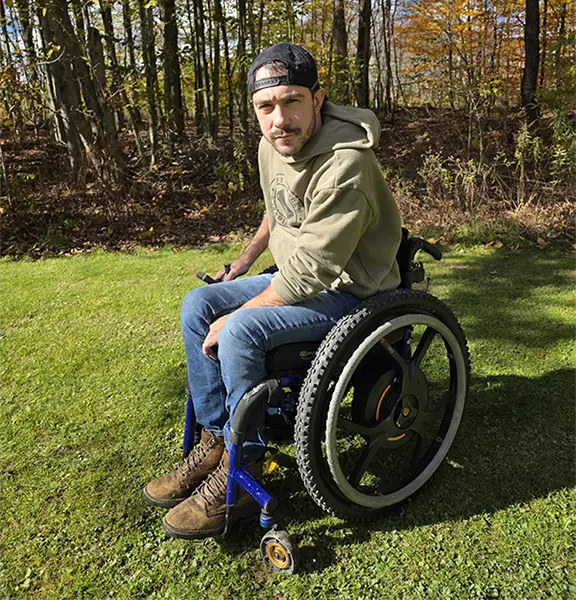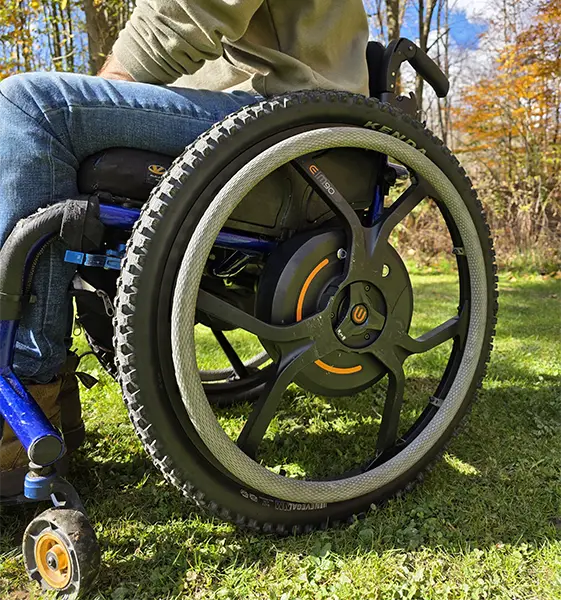Zac was injured in a car accident when he was 19 years old, resulting in an incomplete C 5-6 spinal cord injury. Now in his 30s, Zac has been using a manual wheelchair and states that he feels the stress on his shoulders when he is rolling up a ramp or moving over rough terrain.

The upper extremity is prone to Repetitive Strain Injury (RSI) at the shoulder, elbow, and wrist due to the frequency of arm propulsion. It is estimated that manual wheelchair users push an average of 2,000 to 3,000 times per day (Nag et al., 2012). The chronic repetitive stress on the upper extremity joints results in micro-traumatic injuries (Kentar et al., 2018). Up to 80% of manual wheelchair riders experience pain (Vives Alvarado, 2021) and manual wheelchair riders are 5 to 8 times more likely to report pain than able-bodied individuals (Limpas et al., 2021). The shoulder is the most reported site of injury. While Sekizkardes et al, 2025, found that manual wheelchair riders reported significantly less pain when the center of gravity was configured with elbow at 100 to 120 degrees, repetitive strain injuries may still occur.
 Designed by Freepik
Designed by Freepik
Studies have demonstrated that power assist systems may preserve shoulder health and prolong duration of manual wheelchair use (Atoyebi et al., 2004) or in the case of a toggle, joystick, or tiller, the elimination of manual propulsion altogether.
Richard Bruno, PhD (postpolio.org), an expert in post-polio, coined the phrase, "Conserve to Preserve," to warn people who were experiencing the damage of the polio virus after years of dormancy that overuse or excessive strengthening was doing more harm than good. Instead, he taught joint protection and energy conservation techniques. The same phrase holds true in attempts to preserve the shoulder girdle and decrease the potential for having to move to a power wheelchair when joint damage occurs in manual wheelchair riders.

Zac rides in a QUICKIE Nitrum manual wheelchair with a JAY cushion and back. Zac started using an Empulse M90 wheel add-on with the all-way toggle controller to decrease upper extremity stress when propelling long distances, up ramps, or over uneven terrain. Zac works at a manufacturing site, requiring him to travel distances throughout the company. He drives a car and can transfer his wheelchair in and out of the car independently. The M90 provides Zac with the opportunity to use the toggle when needed and revert back to manually pushing on smoother terrain. Zac has fat tires on his wheelchair due to the fact that he enjoys being outdoors and in challenging environments with his young family. He, his wife, and their four children frequently visit wooded areas for long walks to enjoy the outdoors.
Zac shared this video of him going up a ramp with and without the M90 as well as through a park with rough terrain while playing with his toddler-aged children.
Want to see more of Zac in action? Follow him on Facebook and Instagram.
References
- Algood, S.D., Cooper, R.A., Fitzgerald, S.G., Cooper, R., Boninger, M.L. (2004). Impact of a pushrim-activated power assisted wheelchair on the metabolic demands, stroke frequency, and range of motion among subjects with tetraplegia. Archives of physical medicine and rehabilitation, 85, 1865-71.
- Atoyebi, O., Wister, A., Mattie, J., Beadle, J., Gutman, G., Chaudhury, H., Borisoff, J. (2025). Power assist add-ons for adult manual wheelchair users: A scoping review. Assistive Technology, 37(2), 145–156. https://doi.org/10.1080/10400435.2025.2451933
- Kentar, Y., Zastrow, R., Bradley, H., Brunner, M., Pepke, W., Bruckner, T., Raiss, P., Hug, A., Almansour, H., & Akbar, M. (2018). Prevalence of upper extremity pain in a population of people with paraplegia. Spinal Cord, 56(7):695-703. Doi: 10.1038/s41393-018-0062-6. Epub 2018 Jan 24. Pmid: 29367654.
- Liampas, A., Neophytou, P., Sokratous, M., Varrassi, G., Ioannou, C., Hadjigeorgiou, G. M., & Zis, P. (2021). Musculoskeletal pain due to wheelchair use: A systematic review and meta-analysis. Pain and Therapy, 10(2), 973–984. https://doi.org/10.1007/S40122-021-00294-5
- Nagy, J., Winslow, A., Brown, J. M., Adams, L., O'Brien, K., Boninger, M., & Nemunaitis, G. (2012). Pushrim kinetics during advanced wheelchair skills in manual wheelchair users with spinal cord injury. Topics in spinal cord injury rehabilitation, 18(2), 140–142. https://doi.org/10.1310/sci1802-140
- Sekizkardeş, M., Bardak, A.N., & Öneş, K., Özçakar, L. (2025). Factors associated with shoulder pain in manual wheelchair users with spinal cord injury. American Journal of Physical Medicine and Rehabilitation. doi: 10.1097/PHM.0000000000002759. Epub ahead of print. PMID: 40396620.
- Vives Alvarado. J.R., Felix, E.R., & Gater, D.R. Jr. (2021). Upper extremity overuse injuries and obesity after spinal cord injury. Topics in Spinal Cord Injury Rehabilitation, 27(1):68-74. Doi: 10.46292/Sci20-00061. Pmid: 33814884; Pmcid: Pmc7983631.
With over 40 years of clinical practice as an OT, Jessica Presperin has worked in all sectors of the wheelchair and seating industry as a master clinician, supplier, manufacturing consultant, design representative, and educator. Dr. Presperin was a pioneer in the development of the profession of wheelchairs and seating in the 1980s and has spent the last two decades contributing to the research world to demonstrate evidence for knowledge translation in the clinic, advocacy, and product development. She is a RESNA and AOTA Fellow, serves on the Clinician Task Force, the Seating and Wheeled Mobility Committee for AOTA, and has shared her experiences internationally through publications and presentations.